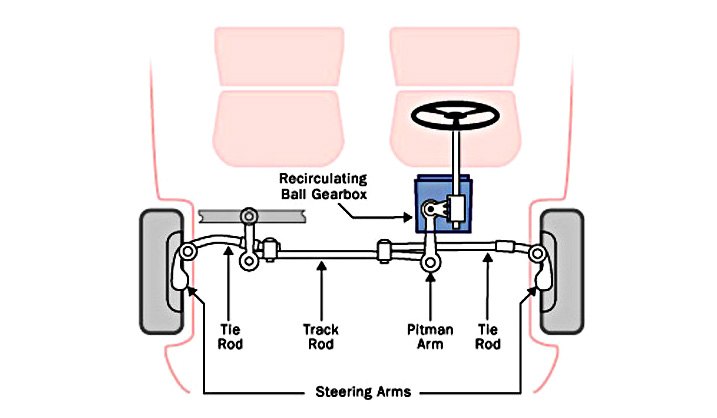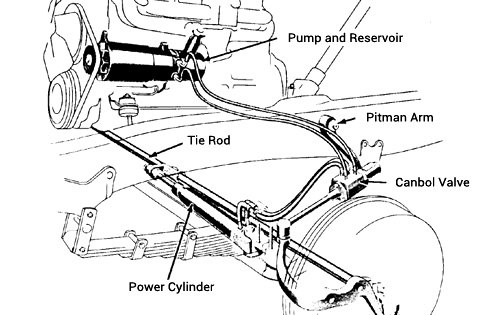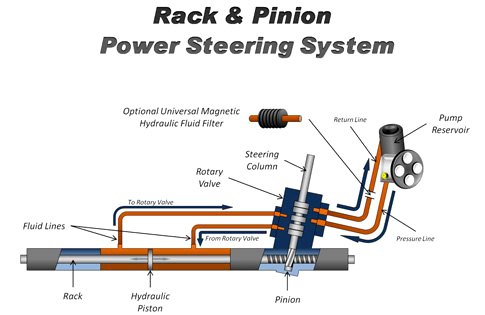Automotive Terminology can throw you a curve ball, when you hear certain terms which might be used interchangeably, or may indicate different systems used on different cars. Take steering: perhaps your uncle said that the steering box on his truck is worn and needs replacement, then your brother said that his steering rack is leaking and needs replacement. Aren't these the same thing? Let's take a systems approach and break it down for you.
First, the mechanical side of things (we'll discuss power steering later). All cars and light duty trucks use one of two types of steering systems: a rack & pinion set-up, or a steering box with recirculating balls.
Rack & Pinion

Rack & pinion is on the vast majority of today's vehicles, and has been for the last few decades. It's simple, compact, direct, and provides great steering feel. On this type of system, a toothed pinion gear mounted on the bottom of your steering column turns with the steering wheel. As that pinion gear rotates, it comes in contact with the “rack” (a long bar with teeth cut into it) – causing the rack to slide left or right. As the rack bar moves, your front wheels turn accordingly.
Tie rod ends at each side of the vehicle provide the final connection between the steering rack and front wheels. They’re designed to flex in many directions to allow for up-and-down movement over bumps, and they can be adjusted in order to reset front wheels straight during an alignment. The moveable ends of the rack are covered with a protective boot or bellows which, like an accordion, can expand and contract with the rack's movement.
If you need a complete rack and pinion assembly, we recommend the Cardone Rack and Pinion Assembly, Maval Remanufactured Rack and Pinion Assembly, and Atlantic Automotive Remanufactured Rack and Pinion Assembly for a wide range of makes and models. For European imports, check out the Bosch Rack and Pinion Assembly and TRW Rack and Pinion Assembly.
Bilstein’s Replacement Steering Rack and Pinion specializes in newer Mercedes models, Hitachi’s Rack and Pinion Assembly is offered mostly for Nissan/Infiniti, Original Equipment’s Steering Rack is designed for Hyundai/Kia, and the Genuine Steering Rack focuses on older Porsches and newer Minis, among other vehicles.
Steering Box

Some of today's heavier trucks have stayed with a steering box, also found on older cars. The typical linkage inside the box is known as a “recirculating ball”, because ball bearings circulate in a spiral path. There are other designs such as worm & roller, and worm & sector. All these designs operate by translating the rotating movement of the steering wheel into left/right movement of a pitman arm.
The pitman arm connects to the front wheels via a track rod or center link, idler arm (which looks like a pitman arm and is located on the opposite side of the car) and tie rods. This system tends to have more "free play" and more parts to wear compared with a rack & pinion set-up.
If your core steering box is worn and in need of replacement, we recommend the Cardone Steering Gear Box, Maval Steering Gear Box, and AC Delco Professional Steering Box (GM, Ford, Dodge trucks) for a large selection of vehicles. If you’ve got a classic GM model back to 1953, the OPGI Power Steering Box probably has you covered. Jeep owners should check out the Crown Power Steering Gear Box and Omix-ADA Steering Gear Box.
Power Steering
“Power steering” is boost produced by a pump which creates tremendous pressure through the use of hydraulic fluid in most cases. This pressure applies force to the steering gear which, in turn, reduces the amount of physical effort required for the driver to turn the steering wheel. Before the first commercially available automotive power steering system was introduced by Chrysler in 1951, all cars and trucks had manual (non-power) steering. It required some extra effort, but larger-diameter steering wheels made it a little easier to apply necessary leverage.
Hydraulic Power Steering Pumps
Whether the vehicle has a steering box or a steering rack, power steering pumps are usually belt-driven – operating only when the engine is running. Pressure and return hoses direct fluid to a control valve and/or steering cylinder in older designs.
Newer vehicles with rack & pinion layouts have control valves and/or pistons set up internally inside the rack. Power steering fluid sits in a reservoir which may be part of the pump, or may be mounted remotely and connected to the pump via a hose.


Electric Steering Boost
One of the newest trends is power steering which is electrically assisted. In some cases, a hydraulic pump gets its energy from an electric motor instead of belt. Increasingly, the power steering pump itself is an electric motor, without the need for any hydraulics.
When it comes to electric power assist motors, we’ve got a selection from Cardone and Auto 7. For all-electric racks, there’s the Cardone Electric Rack & Pinion Assembly, Bosch Remanufactured Electric Power Steering Rack and Pinion Assembly (select Audi models), and Genuine Remanufactured Electric Power Steering Rack & Pinion Assembly (Mini).
Summing It Up
To sum things up, you should know that certain components are part of steering box and rack-and-pinion systems - both of which similarly use a power steering pump, reservoir, and hoses. For example:
Components in a Steering Box Setup
If you have a steering box, or recirculating ball steering, you have:
- A steering box;
- A pitman arm, idler arm, and center link or track rod;
- Tie rod ends.
Components in a Rack-and-Pinion Setup
If you have rack-and-pinion steering, you have:
- A steering rack;
- Boots or bellows;
- Tie rod ends.

If your steering system is in need of repair, you’ve come to the right place. At CARiD, we have new and rebuilt steering boxes as well as replacement gaskets and seals for pitman arms, input shafts, pinion gears, gear box housings, hardware, and more. If your vehicle has a rack, we’ve got complete rack-and-pinion assemblies, bellow cover pieces, spacers, gaskets/seals, electrical assist motors, and anything else you’re likely to need. Just look along the left side of the screen, and select any applicable check boxes for these and other individual items. And if you have any questions or need assistance during your purchase, our knowledgeable product reps will be glad to steer you straight!

